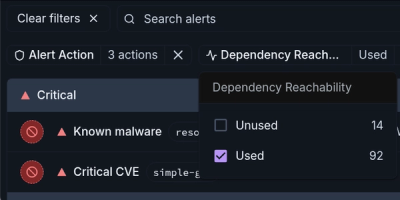
Product
Introducing Historical Analytics – Now in Beta
We’re excited to announce a powerful new capability in Socket: historical data and enhanced analytics.
unist-util-position
Advanced tools
The unist-util-position package is a utility for working with positional information in unist syntax trees. It provides functions to get and manipulate positions of nodes within these trees, which is useful for tasks such as error reporting, syntax highlighting, and more.
position.start
This feature retrieves the starting position of a node. The code sample demonstrates how to use the `position.start` function to get the starting line and column of a node.
const position = require('unist-util-position');
const node = { position: { start: { line: 1, column: 1 }, end: { line: 1, column: 5 } } };
console.log(position.start(node)); // { line: 1, column: 1 }position.end
This feature retrieves the ending position of a node. The code sample shows how to use the `position.end` function to get the ending line and column of a node.
const position = require('unist-util-position');
const node = { position: { start: { line: 1, column: 1 }, end: { line: 1, column: 5 } } };
console.log(position.end(node)); // { line: 1, column: 5 }position.point
This feature normalizes a point object. The code sample demonstrates how to use the `position.point` function to ensure a point object has the correct structure.
const position = require('unist-util-position');
const point = { line: 1, column: 1 };
console.log(position.point(point)); // { line: 1, column: 1 }The unist-util-visit package is used to recursively walk through unist syntax trees. While it doesn't specifically handle positional information, it can be used in conjunction with unist-util-position to traverse nodes and then retrieve their positions.
The unist-util-find package helps in finding nodes in unist syntax trees based on certain criteria. It can be used to locate nodes and then unist-util-position can be used to get their positional information.
The unist-util-select package allows for selecting nodes in unist syntax trees using CSS-like selectors. Once nodes are selected, unist-util-position can be used to get their positions. This package is useful for more complex queries within the tree.
unist utility to get positional info of nodes.
This utility helps with accessing positional info on a potentially dirty tree.
The positional info is typically consistent and proper in unist trees generated by our ecosystem, but, user plugins could mess that up. If you’re making a reusable plugin, and accessing the positional info often, you might want to guard against that by using this utility.
You might also find the utility unist-util-generated
useful to check whether a node is considered to be generated (not in the
original input file).
You might also enjoy
unist-util-stringify-position when you want
to display positional info to users.
This package is ESM only. In Node.js (version 16+), install with npm:
npm install unist-util-position
In Deno with esm.sh:
import {pointEnd, pointStart, position} from 'https://esm.sh/unist-util-position@5'
In browsers with esm.sh:
<script type="module">
import {pointEnd, pointStart, position} from 'https://esm.sh/unist-util-position@5?bundle'
</script>
import {fromMarkdown} from 'mdast-util-from-markdown'
import {pointEnd, pointStart, position} from 'unist-util-position'
const tree = fromMarkdown('# foo\n\n* bar\n')
console.log(position(tree))
console.log(pointStart(tree))
console.log(pointEnd(tree))
Yields:
{start: {line: 1, column: 1, offset: 0}, end: {line: 4, column: 1, offset: 13}}
{line: 1, column: 1, offset: 0}
{line: 4, column: 1, offset: 13}
This package exports the identifiers pointEnd,
pointStart, and position.
There is no default export.
position(node)Get the positional info of node.
node (Node)
— nodePosition, if valid (Position or undefined).
pointEnd(node)Get the ending point of node.
node (Node)
— nodePoint, if valid (Point or undefined).
pointStart(node)Get the starting point of node.
node (Node)
— nodePoint, if valid (Point or undefined).
This package is fully typed with TypeScript. It exports no additional types.
Projects maintained by the unified collective are compatible with maintained versions of Node.js.
When we cut a new major release, we drop support for unmaintained versions of
Node.
This means we try to keep the current release line, unist-util-position@^5,
compatible with Node.js 16.
unist-util-stringify-position
— serialize a node, position, or point as a human readable locationunist-util-position-from-estree
— get a position from an estree nodeunist-util-remove-position
— remove positions from treeunist-util-generated
— check if a node is generatedunist-util-source
— get the source of a nodeSee contributing.md in syntax-tree/.github for
ways to get started.
See support.md for ways to get help.
This project has a code of conduct. By interacting with this repository, organization, or community you agree to abide by its terms.
FAQs
unist utility to get the position of a node
The npm package unist-util-position receives a total of 6,561,248 weekly downloads. As such, unist-util-position popularity was classified as popular.
We found that unist-util-position demonstrated a not healthy version release cadence and project activity because the last version was released a year ago. It has 2 open source maintainers collaborating on the project.
Did you know?

Socket for GitHub automatically highlights issues in each pull request and monitors the health of all your open source dependencies. Discover the contents of your packages and block harmful activity before you install or update your dependencies.

Product
We’re excited to announce a powerful new capability in Socket: historical data and enhanced analytics.

Product
Module Reachability filters out unreachable CVEs so you can focus on vulnerabilities that actually matter to your application.

Company News
Socket is bringing best-in-class reachability analysis into the platform — cutting false positives, accelerating triage, and cementing our place as the leader in software supply chain security.